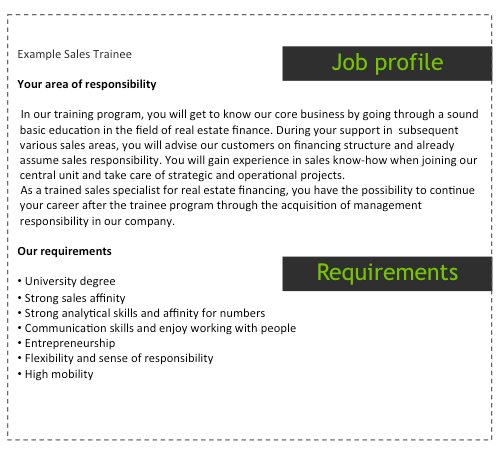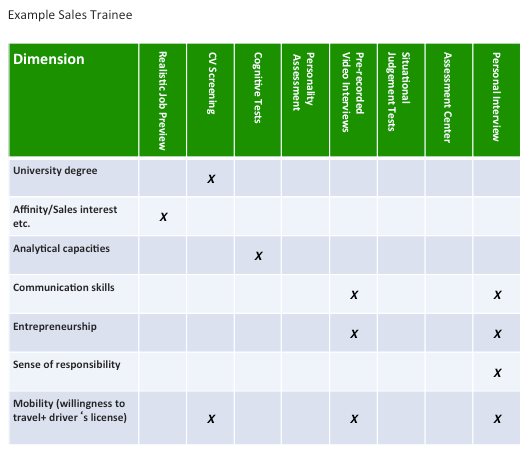Recruiting Guide–3 Steps from the Job profile to the Personnel Selection Procedure

Let’s go back to the basics: In personnel selection, most recruiters put the focus on filtering out unsuitable candidates. In times of talent shortage, however, this is quite problematic. It is equally important to NOT filter out qualified candidates too early. You just cannot afford to lose suitable candidates.
Why are we rejecting the right candidates too often?
The usage of screening procedures is an important part of high-volume recruitment. Internet testing is fast,economical and easy to administrate. Nevertheless, too often non-valid criteria are used when out-screening is based on school grades or test scores that did not fit the actual job requirements. Unfortunately, rejecting a candidate who actually meets the requirements of the job usually remains undetected. This is called “Type II Error” in psychological literature.
What can be done? Single selection procedures have a unique scope of coverage, while other aspects of person-job or person-organization fit have not been covered. As a result, the risk of overseeing true potentials in the candidates is quite high. Just remember that a lot of today’s business leaders are college dropouts. Would you have hired them based on their CV? Therefore, a smart combination of various selection procedures helps to enlighten hidden talents and gain a coherent picture.
A smart combination of various selection methods provides additional information.
Unfortunately, there is no thing such as THE perfect method mix, per se. To get the best results, a job analysis and definition of competency dimensions is crucial. After having this foundation, the next step is to arrange different procedures in a way that is most suited to cover different competency dimensions (technical knowledge, soft skills, abilities, professional experience) and deliver a complete picture, which is called incremental validity. The final result is more than the sum of its parts.
In a concrete example, we show you how to build an optimal selection procedure in three steps—starting from establishing the job profile.
Step 1: Set up a job profile with your hiring managers
Before you start choosing your procedures, you need to set up a competency profile for your vacancy:
- What will be the candidate‘s specific tasks and activities?
- What skills, knowledge, and experience are necessary to perform well?
- What can be learned? What skills are indispensable?
- What distinguishes good staff from lesser employees in critical situations?

Step 2: Match skills with selection procedures
- What are the specific requirements? (e.g. you need someone with strong analytical skills → you need to test his /her logical reasoning, numerical intelligence)
- What procedures are best proven to assess these requirements? (e.g. analytical skills can be checked with a cognitive performance test)
- How can various selection procedures be combined so that they complement one another?

- Which selection methods are best suited for which step in the recruiting process?
- What are the criteria a candidate has to match in order to be admitted to the next step in the recruiting process?

1. Realistic Job Preview
Description:Applicants are expected to get a realistic insight into the working day through videos or blogs, for example.
Target Area:Decision support for candidates. They choose whether they want to apply and whether the job profile suits their interests (self-selection).
What you should pay attention to: It is important for you as a company to stay authentic. Otherwise, you create expectations that you cannot fulfill, which leads to a risk of high employee turnover.
2. Resume Screening
Description: Biography/hard facts screening: working experience, references
Target Area: Hard facts such as diploma, achievements in professional life
What you should pay attention to: Resume screening is focused on hard “must-haves“. Do not interpret hard facts in relation to soft skills as there is a strong risk of misinterpretation and wrong decision-making
3.Pre-recorded Video Interviews
Description: Suited for pre-selection. Candidates record answers to job-specific interview questions via webcam. Recruiter and hiring managers rate these answers according to pre-defined criteria and in a structured way.
Target Area: Reported knowledge, motivation, foreign language skills and other areas of expertise.
What you should pay attention to: The more structured and job-related the questions, the better you can assess a candidate‘s job fit.
4. Cognitive Performance Tests
Description: (Online-) tests measuring specific cognitive abilities; classification of the test value (score) is based on a normative sample.
Target Area: Numerical/verbal/figural/spatial ability, logical reasoning, specific abilities
What you should pay attention to: When it comes to white-collar jobs that require analytical skills, cognitive performance tests will be a good predictor of a candidate’s suitability. For other jobs such as sales manager, those cognitive tests are not necessary.
5. (Online) Assessment Center (AC)
Description: Candidates do different tasks/exercises, such as staff meetings and group discussions. The assessment is done by trained observers.
Target Area: Behavior analysis in controlled situations
What you should pay attention to: Poor validity if AC is not adapted to the job requirements. Risk of observer errors.
6. Personal Interview
Description: Personal interview/exchange of job-related information between candidate and interviewer; various special interview systems (e.g. situational interviews).
Target Area: Reported knowledge/ motivation/foreign language skills and other areas of expertise.
What you should pay attention to: Structured interviews and interviewer training are critical to success. Poor validity if interviews are unstructured.

